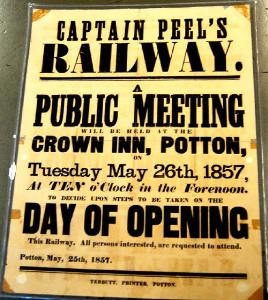Captain Peels Railway

A poster advertising a public meeting to decide proceedings on the opening day of the Sandy & Potton Railway.
The railways originally came to Potton on 9th November 1857 when the Sandy and Potton Railway opened. It was more commonly known as Captain Peel's Railway after its creator Captain Sir William Peel VC. It was the fifth railway to be built in Bedfordshire and ran for just three miles between, as the name suggests, Sandy and Potton. Captain Peel was third son of Robert Peel, the former Prime Minister, and had an estate between the two towns. When the Great Northern Railway, which ran through Sandy opened in 1850 he decided to build a branch line to connect his estate to it. Construction began in 1855.
By that time Captain Peel was serving in the Black Sea during the Crimean War during which he won the newly created Victoria Cross and at the end of which he was given command of a frigate, HMS Shannon, and ordered to China. Captain Peel's mother opened the railway and its locomotive was named, inevitably, Shannon. Peel never used his railway, en route to China he was diverted to India as the Mutiny had broken out and he died of smallpox on 22nd April 1858. Remarkably, the locomotive survives at the Didcot Railway Centre in Oxfordshire. Even more remarkably, its engine shed still survives in a field at Potton as a vegetable store. The journey time from Potton to Sandy was ten minutes.
Captain Peel's private railway did not long survive him. His brother Arthur acquired it and put it up for sale. It was bought by the Bedford and Cambridge Railway. in 1861 for £20,000, being £5,000 more than it had cost to build. The railway was immediately closed to allow the track bed to be rebuilt. The London North Western Railway took the Bedford and Cambridge Railway on lease in 1865 and doubled the track. The line closed just over a hundred years later, in 1967, the bridges being demolished in the following year.